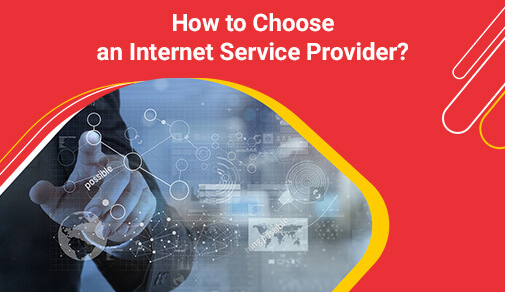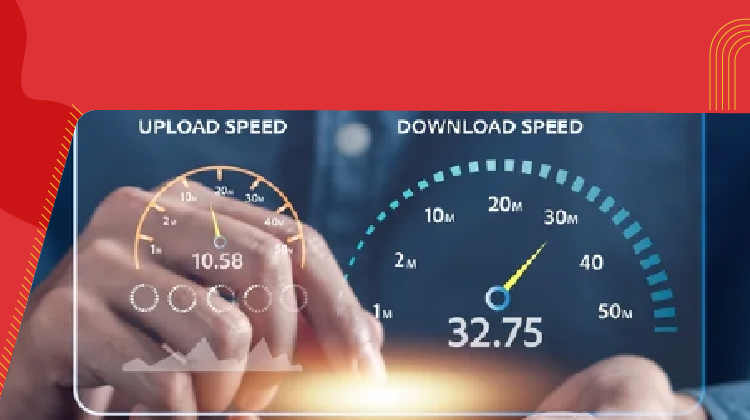Tips to choose an internet service provider
Tuesday, Jan 18, 2022 · 11 minutes


TIPS TO CHOOSE AN INTERNET SERVICE PROVIDER
Tuesday, Jan 18, 2022 · 11 minutes
When choosing your Internet Provider, there are a lot of factors that you need to consider. You would opt for the most reliable and fastest Internet service as per your broadband needs to ensure productivity. In this era, communication is fundamental for working professionals, students and high-speed access is crucial for uninterrupted access to clients and suppliers.
Businesses today can barely keep up with increased bandwidth demand. Employees now need to work on multiple devices, in multiple locations, virtually 24X7. In a Cisco Survey, it's estimated that in 2022, there will be 3.6 networked devices connected to the internet for every human on Earth. You'll want to decide your internet service provider based on your current needs and the kind of growth you are expecting to see in the future.
Also, because high-bandwidth apps such as HD video calling and other business applications are becoming the new business standard, it's crucial to keep a tab on what the major Internet Services Providers (ISPs) are giving in terms of new products and services.
DSL is an internet connection where data is transmitted over telephone lines. Telephone lines are made of copper; while copper is a great conductor, a DSL connection cannot move data as fast as a cable or fibernet internet connection. One crucial factor that will affect your decision on DSL is the distance between your home and the telephone provider's office. This means that the farther you are from the mainline, the weaker the signal and the slower the internet connection.
Cable internet connections run on telephone lines that use coaxial cables to transmit data, and these can carry more bandwidth than a direct subscriber line connection. When compared to DSL, a cable connection's connectivity does not depend on the distance. However, unlike a DSL connection, a dedicated telephone line, cable connections are usually shared among users. This would mean that the bandwidth gets divided among users, also a lesser secure option. In terms of speed, cable connections are 3 to 4 times faster than DSL and provide speeds of 10-50 Mbps usually.
Fiber optic cables are the latest technology in the internet service business. With these cables, the data can transmit at the speed of light. Unlike cable or DSL, the transmission happens over the glass, immune to all interference. There are two broad types of fiber connections - direct internet access (DIA) and fibernet broadband. Direct internet access is an option more commonly used by businesses as it is a dedicated internet line that provides more security and reliability of connectivity. Individuals use Fibernet broadband at home. Fibernet speeds range from 150 Mbps to 1000 Mbps.
The first step to buying a broadband connection for your home is understanding your internet usage. List down the activities you use internet services for and the amount of data they consume. The below table should help in giving a brief idea of internet speed, data, and usage.
Speak to your neighbours to find out the most used internet service provider in your area. Create a list of 4-5 internet service providers in your locality and list down their plans and tariff basis your internet usage. The chances are that the most used internet service provider has the best customer service in your area.
After making a list of the top 4-5 internet service providers in your locality, look out for the top offers. Most ISPs have offers on their full-time plans. For example, with most six-month plans, ACT Fibernet offers a free router/extra month of internet and free installation. These offers will help you save a lot of costs in the long run.
After purchasing your internet plan, do run an internet speed test to check the speed test results that your ISP is delivering. You can check your internet speed on ookla speed test. Know more about speed test results here.
Choosing an Internet service provider can be difficult, especially if you aren't sure what questions to ask. Getting all of the facts before signing on the dotted line is one of the secrets to loving the Internet service provider you choose. We've put up a list of questions you should ask yourself so you can be a wise Internet shopper.
A wired network may be the best option if the expense of updating your network is an issue and you need the highest level of security and performance. A wired connection may be sufficient for your office needs if mobility is not an issue. If you don't care about cost and desire mobility and cutting-edge technology, a wireless network should be seriously considered. Most customers pick between wired and mobile broadband depending on their internet speed requirements, but if you choose wired, you must also choose between cable and fibre networks.
In India, copper-based broadband is fairly prevalent, and it is frequently combined with a fixed telephone landline connection from the same ISP. Even with various developments in this field such as ADSL, VDSL, and VDSL2+, copper upload speeds range from 5 to 10 Mbps, while download speeds range from 15 to 70 Mbps, with minor oscillations. The availability of fibre broadband is one issue. In order to bring fibre broadband to a region, fibre optic connections must be built. This is one of the reasons why fibre broadband penetration in India is still quite low. DSL, on the other hand, uses telephone lines, therefore a copper internet connection may be found almost anywhere.
The contention ratio is a critical parameter that determines the maximum number of internet users who can share a fixed bandwidth on a single line at the same time. So, even if you choose a high-speed internet connection, if there are a lot of people using it, the contention ratio will be high, and the internet speed per user will always be low. If the contention ratio is 1:8, for example, up to 8 homes can share the bandwidth at the same time. In India, most ISPs currently offer a 1:30 contention ratio. With the recent introduction of Fiber to the Home (FTTH) Internet in India, you may now have dedicated 1:1 bandwidth, ensuring that you get the speed you pay for with no latency or sharing.
Data limits are constraints placed on your Internet usage by your Internet service provider. Not all Internet service providers will impose a data cap, and some may impose both soft and hard limits. A hard data limit means that once you've used a specific amount of data, you'll either be charged an overage fee or be cut off entirely.
Unfortunately, most Internet providers do not issue speed guarantees, but it never hurts to inquire. Find out what you can do if your internet isn't working at the speed of your plan, even if they don't offer performance guarantees. Slow speeds can occur as a result of equipment failure or a high number of users utilising your connection.
To activate your ACT Fibernet connection, you can follow the below simple steps
##BlogVASBanner##
The very first step to buying a broadband for your home is understanding your internet usage. List down the activities that you use internet services for and the amount of data they consume. The below table should help in giving a brief idea of internet speed, data and your usage.
| 0-5 Mbps | 5-40 Mbps | 40-100 Mbps | 100-500 Mbps | 500-1,000+ Mbps |
|---|---|---|---|---|
| Works for: Checking email | Works for: Streaming video on one device | Works for: Streaming HD video on a few devices | Works for: Streaming video in UHD on multiple screens | Works for: Doing a lot of almost anything |
| Streaming music on one device | Video calling with Skype or FaceTime | Multiplayer online gaming | Downloading files quickly | |
| Searching on Google | Online gaming for one player | Downloading large files | Gaming online for multiple players |
Speak to your neighbours to find out the most used internet service provider in your area. Chances are that the most used internet service provider has the best customer service in your area. Create a list of 4-5 internet service providers in your locality and list down their plans and tariff basis your internet usage.
After making a list of the top 4-5 internet service providers in your locality, lookout for offers that each of these providers are offering. Most ISPs have offers on their full time plans. For example, with most 6 months plans, ACT Fibernet offers a free router/free extra month of internet and free installation. These offers will help you save a lot of cost in the long run.
After purchasing your internet plan, do run an internet speed test to check the speed test results that your ISP is delivering. You can check your internet speed on ookla speed test. Know more about speed test results here.
Choosing an Internet service provider can be difficult, especially if you aren't sure what questions to ask. Getting all of the facts before signing on the dotted line is one of the secrets to loving the Internet service provider you choose. We've put up a list of questions you should ask yourself so you can be a wise Internet shopper.
A wired network may be the best option if the expense of updating your network is an issue and you need the highest level of security and performance. A wired connection may be sufficient for your office needs if mobility is not an issue. If you don't care about cost and desire mobility and cutting-edge technology, a wireless network should be seriously considered. Most customers pick between wired and mobile broadband depending on their internet speed requirements, but if you choose wired, you must also choose between cable and fibre networks.
In India, copper-based broadband is fairly prevalent, and it is frequently combined with a fixed telephone landline connection from the same ISP. Even with various developments in this field such as ADSL, VDSL, and VDSL2+, copper upload speeds range from 5 to 10 Mbps, while download speeds range from 15 to 70 Mbps, with minor oscillations. The availability of fibre broadband is one issue. In order to bring fibre broadband to a region, fibre optic connections must be built. This is one of the reasons why fibre broadband penetration in India is still quite low. DSL, on the other hand, uses telephone lines, therefore a copper internet connection may be found almost anywhere.
The contention ratio is a critical parameter that determines the maximum number of internet users who can share a fixed bandwidth on a single line at the same time. So, even if you choose a high-speed internet connection, if there are a lot of people using it, the contention ratio will be high, and the internet speed per user will always be low. If the contention ratio is 1:8, for example, up to 8 homes can share the bandwidth at the same time. In India, most ISPs currently offer a 1:30 contention ratio. With the recent introduction of Fiber to the Home (FTTH) Internet in India, you may now have dedicated 1:1 bandwidth, ensuring that you get the speed you pay for with no latency or sharing.
Data limits are constraints placed on your Internet usage by your Internet service provider. Not all Internet service providers will impose a data cap, and some may impose both soft and hard limits. A hard data limit means that once you've used a specific amount of data, you'll either be charged an overage fee or be cut off entirely.
Unfortunately, most Internet providers do not issue speed guarantees, but it never hurts to inquire. Find out what you can do if your Internet isn't working at the speed of your plan, even if they don't offer performance guarantees. Slow speeds can occur as a result of equipment failure or a high number of users utilising your connection.
To activate your ACT Fibernet connection, you can follow the below simple steps
Follow the below steps to activate your act WiFi router
Here’s a quick step by step run down of how to connect your computer to the internet:
The most important factor to consider is reliability. You need a very reliable internet option that is uninterrupted everytime you need it. Downtime could hurt your bottom line if you lose customers and sales because of unreliable Internet service. The more connections you have, the higher the bandwidth. Most business applications, such as file sharing and online backups, require higher upload speeds and hence, a fast connection with equal upload and download speed is the key effective connectivity. A fast reliable connection allows for -
101

The New Social: How High-Speed Internet is Redefining 'Quality Time' with Friends and Family
Read more387

How ACT SmartWi-Fi is Redefining Home Internet in 2025: The Age of AI-Powered Seamless Connectivity
Read more152

From Bandwidth to Intelligence: How AI Is Redefining Business Demands from ISPs
Read more
A referral link has been sent to your friend.
Once your friend completes their installation, you'll receive a notification about a 25% discount on your next bill
![]() Please wait while we redirect you
Please wait while we redirect you

![]() One of our representatives will reach out to you shortly
One of our representatives will reach out to you shortly

One of our representatives will reach out to your shortly
![]() Please wait while we redirect you
Please wait while we redirect you

Please enter your registered phone number to proceed

Please enter correct OTP to proceed


Dear customer you are successfully subscribed
Please wait while we redirect you

Your ACT Shield subscription has been successfully deactivated

Dear user, Your account doesn't have an active subscription

Dear customer Entertainment pack is already activated.
Please wait while we redirect you